
A road is a thoroughfare, route, or way on land between two places that has been paved or otherwise improved to allow travel by foot or some form of conveyance, including a motor vehicle, cart, bicycle, or horse.
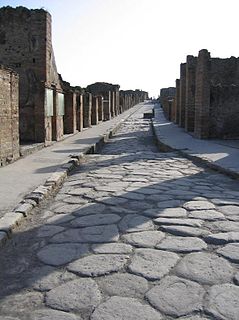
Roman roads were physical infrastructure vital to the maintenance and development of the Roman state, and were built from about 300 BC through the expansion and consolidation of the Roman Republic and the Roman Empire. They provided efficient means for the overland movement of armies, officials, and civilians, and the inland carriage of official communications and trade goods. Roman roads were of several kinds, ranging from small local roads to broad, long-distance highways built to connect cities, major towns and military bases. These major roads were often stone-paved and metaled, cambered for drainage, and were flanked by footpaths, bridleways and drainage ditches. They were laid along accurately surveyed courses, and some were cut through hills, or conducted over rivers and ravines on bridgework. Sections could be supported over marshy ground on rafted or piled foundations.

The Dwight D. Eisenhower National System of Interstate and Defense Highways, commonly known as the Interstate Highway System, is a network of controlled-access highways that forms part of the National Highway System in the United States. The system is named for President Dwight D. Eisenhower, who championed its formation. Construction was authorized by the Federal Aid Highway Act of 1956, and the original portion was completed 35 years later, although some urban routes were cancelled and never built. The network has since been extended. In 2016, it had a total length of 48,181 miles (77,540 km). As of 2016, about one-quarter of all vehicle miles driven in the country use the Interstate system. In 2006, the cost of construction was estimated at about $425 billion.

A highway is any public or private road or other public way on land. It is used for major roads, but also includes other public roads and public tracks: It is not an equivalent term to controlled-access highway, or a translation for autobahn, autoroute, etc.

The Silk Road was an ancient network of trade routes that connected the East and West. It was central to cultural interaction between the regions for many centuries. The Silk Road primarily refers to the terrestrial routes connecting East Asia and Southeast Asia with East Africa, West Asia and Southern Europe.

U.S. Route 66, also known as the Will Rogers Highway, the Main Street of America or the Mother Road, was one of the original highways in the U.S. Highway System. US 66 was established on November 11, 1926, with road signs erected the following year. The highway, which became one of the most famous roads in the United States, originally ran from Chicago, Illinois, through Missouri, Kansas, Oklahoma, Texas, New Mexico, and Arizona before ending in Santa Monica in Los Angeles County, California, covering a total of 2,448 miles (3,940 km). It was recognized in popular culture by both the hit song "(Get Your Kicks on) Route 66" and the Route 66 television show in the 1960s. In John Steinbeck's classic American novel, The Grapes of Wrath (1939), the road, "Highway 66", was turned into a powerful symbol of escape and loss.

A toll road, also known as a turnpike or tollway, is a public or private road for which a fee is assessed for passage. It is a form of road pricing typically implemented to help recoup the cost of road construction and maintenance.

Wile E. Coyote and the Road Runner are a duo of cartoon characters from the Looney Tunes and Merrie Melodies series of cartoons. In each episode, the Coyote repeatedly attempts to catch and subsequently eat the Road Runner, a fast-running ground bird, but is never successful. Instead of his animal instincts, the Coyote uses absurdly complex contraptions to try to catch his prey, which comically "backfire", with the Coyote often getting injured in slapstick fashion. Many of the items for these contrivances are mail-ordered from a variety of companies that are all named Acme.

Abbey Road Studios is a recording studio at 3 Abbey Road, St John's Wood, City of Westminster, London, England. It was established in November 1931 by the Gramophone Company, a predecessor of British music company EMI, which owned it until Universal Music took control of part of EMI in 2013.

Left-hand traffic (LHT) and right-hand traffic (RHT) are the practice, in bidirectional traffic, of keeping to the left side or to the right side of the road, respectively. A fundamental element to traffic flow, it is sometimes referred to as the rule of the road.

The National Highway is a system of roads connecting all mainland states and territories of Australia, and is the major network of highways and motorways connecting Australia's capital cities and major regional centres.
The Grand Trunk Road is one of Asia's oldest and longest major roads — founded around 3rd century BCE by the Mauryan Empire of ancient India. For more than two millennia, it has linked the South Asia with Central Asia. It runs from Chittagong through to Dhaka in Bangladesh then across Northern India through Delhi, passing from Amritsar. From there, the road continues towards Lahore and Peshawar in Pakistan, finally terminating in Kabul, Afghanistan.
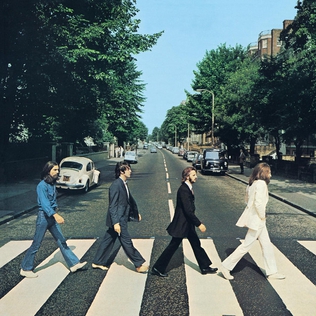
Abbey Road is the eleventh studio album by English rock band the Beatles, released on 26 September 1969 by Apple Records. The recording sessions for the album were the last in which all four Beatles participated. Although Let It Be was the final album that the Beatles completed before the band's dissolution in April 1970, most of the album had been recorded before the Abbey Road sessions began. A two-sided hit single from the album, "Something" backed with "Come Together", released in October, topped the Billboard Hot 100 chart in the US.

A controlled-access highway is a type of highway which has been designed for high-speed vehicular traffic, with all traffic flow ingress- and egress-regulated. Common English terms are freeway, motorway and expressway. Other similar terms include Interstate and parkway. Some of these may be limited-access highways, although this term can also refer to a class of highway with somewhat less isolation from other traffic.
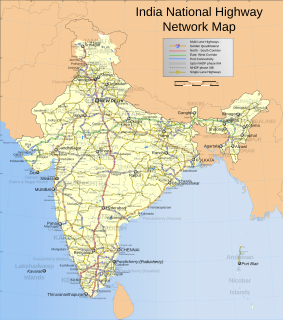
India has a road network of over 5,903,293 kilometres (3,668,136 mi) as of 31 January 2019, the second largest road network in the world. At 1.70 km of roads per square kilometre of land, the quantitative density of India's road network is higher than that of Japan (0.91) and the United States (0.989888) to, and far higher than that of China (0.46), Brazil (0.18) or Russia (0.08). Adjusted for its large population, India has approximately 4.63 km of roads per 1000 people. However, qualitatively India's roads are a mix of modern highways and narrow, unpaved roads, and are being improved. As on 31 March 2016, 62.5% of Indian roads were paved.

Transport or transportation is the movement of humans, animals and goods from one location to another. In other words the action of transport is defined as a particular movement of an organism or thing from a point A to the Point B. Modes of transport include air, land, water, cable, pipeline and space. The field can be divided into infrastructure, vehicles and operations. Transport is important because it enables trade between people, which is essential for the development of civilizations.
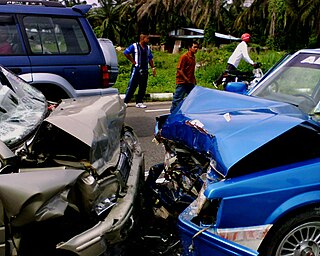
A traffic collision, also called a motor vehicle collision (MVC) among other terms, occurs when a vehicle collides with another vehicle, pedestrian, animal, road debris, or other stationary obstruction, such as a tree, pole or building. Traffic collisions often result in injury, death, and property damage.
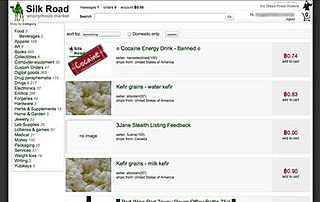
Silk Road was an online black market and the first modern darknet market, best known as a platform for selling illegal drugs. As part of the dark web, it was operated as a Tor hidden service, such that online users were able to browse it anonymously and securely without potential traffic monitoring. The website was launched in February 2011; development had begun six months prior. Initially there were a limited number of new seller accounts available; new sellers had to purchase an account in an auction. Later, a fixed fee was charged for each new seller account.

Mad Max: Fury Road is a 2015 post-apocalyptic action film co-written, produced, and directed by George Miller. Miller collaborated with Brendan McCarthy and Nico Lathouris on the screenplay. The fourth installment and a revisiting. of the Mad Max franchise, it is a joint Australian-American venture produced by Kennedy Miller Mitchell, RatPac-Dune Entertainment, and Village Roadshow Pictures. The film is set in a post-apocalyptic desert wasteland where petrol and water are scarce commodities. It follows Max Rockatansky, who joins forces with Imperator Furiosa to flee from cult leader Immortan Joe and his army in an armoured tanker truck, leading to a lengthy road battle. The film also features Nicholas Hoult, Rosie Huntington-Whiteley, Riley Keough, Zoë Kravitz, Abbey Lee, and Courtney Eaton.

The Belt and Road Initiative (BRI), also known as the One Belt One Road (OBOR) or the Silk Road Economic Belt and the 21st-century Maritime Silk Road, is a development strategy adopted by the Chinese government involving infrastructure development and investments in 152 countries and international organizations in Europe, Asia, Middle East, Latin America and Africa. The paramount leader of the People's Republic of China, Xi Jinping, originally announced the strategy during official visits to Indonesia and Kazakhstan in 2013. "Belt" refers to the overland routes for road and rail transportation, called "the Silk Road Economic Belt"; whereas "road" refers to the sea routes, or the 21st Century Maritime Silk Road. Until 2016 the initiative was officially known in English as the One Belt and One Road initiative but the official name was changed as the Chinese government considered the emphasis on the word "one" as being prone to misinterpretation.






















